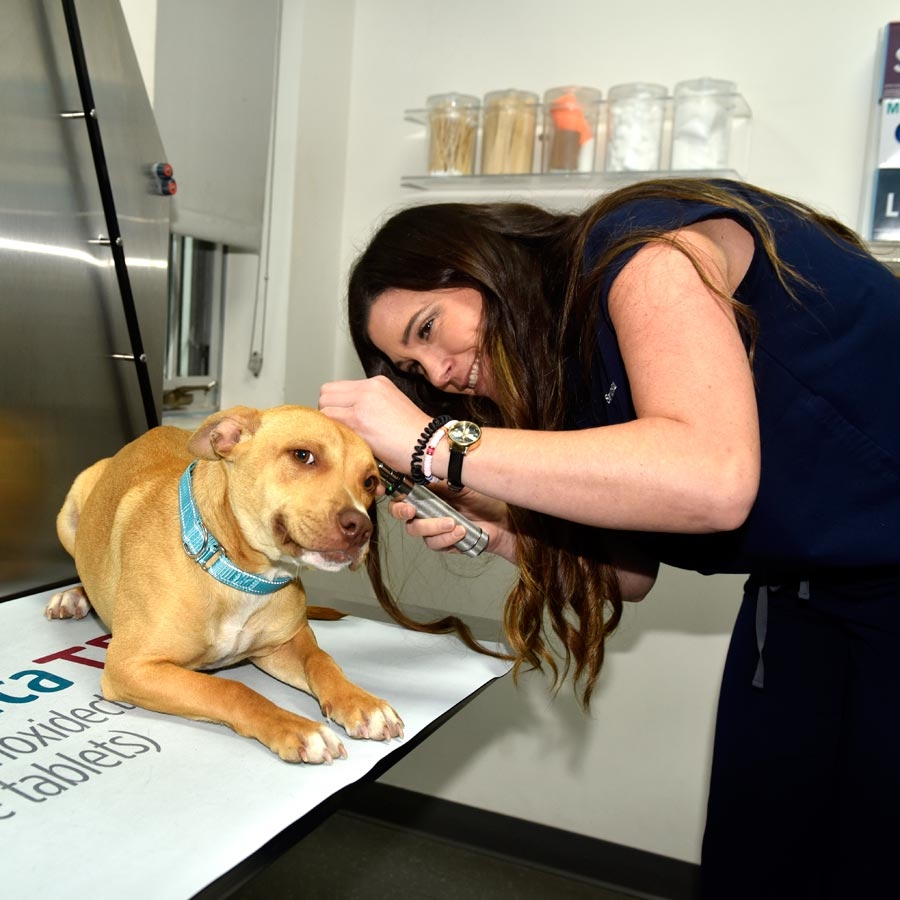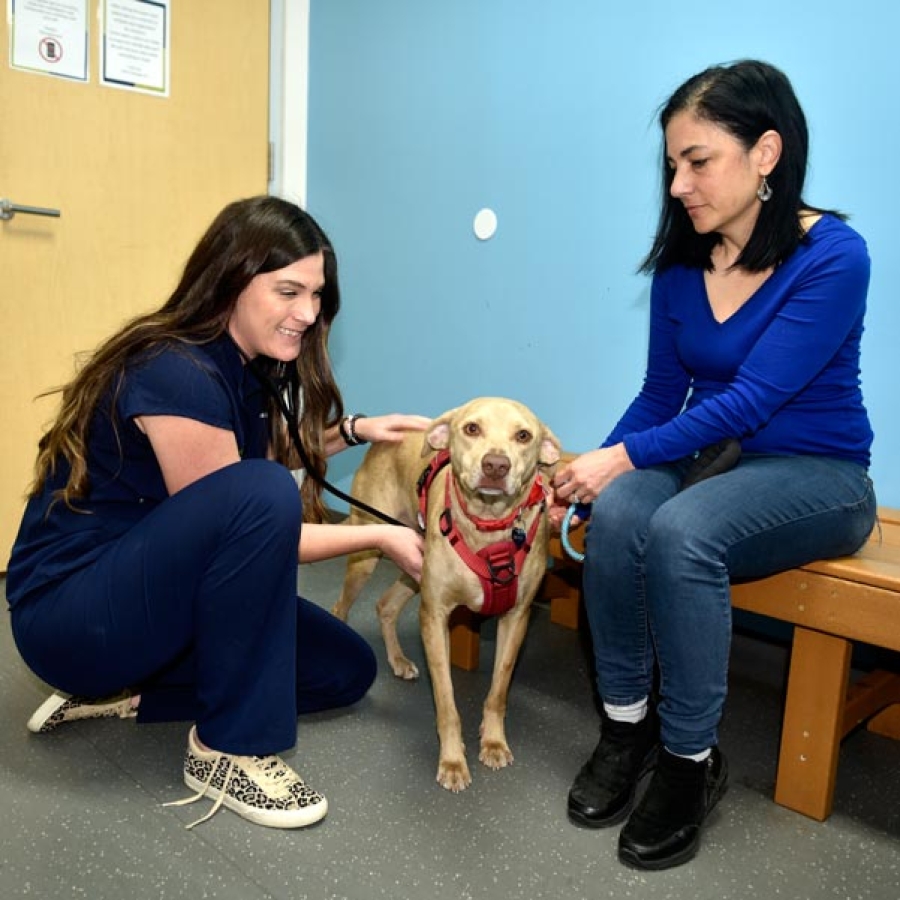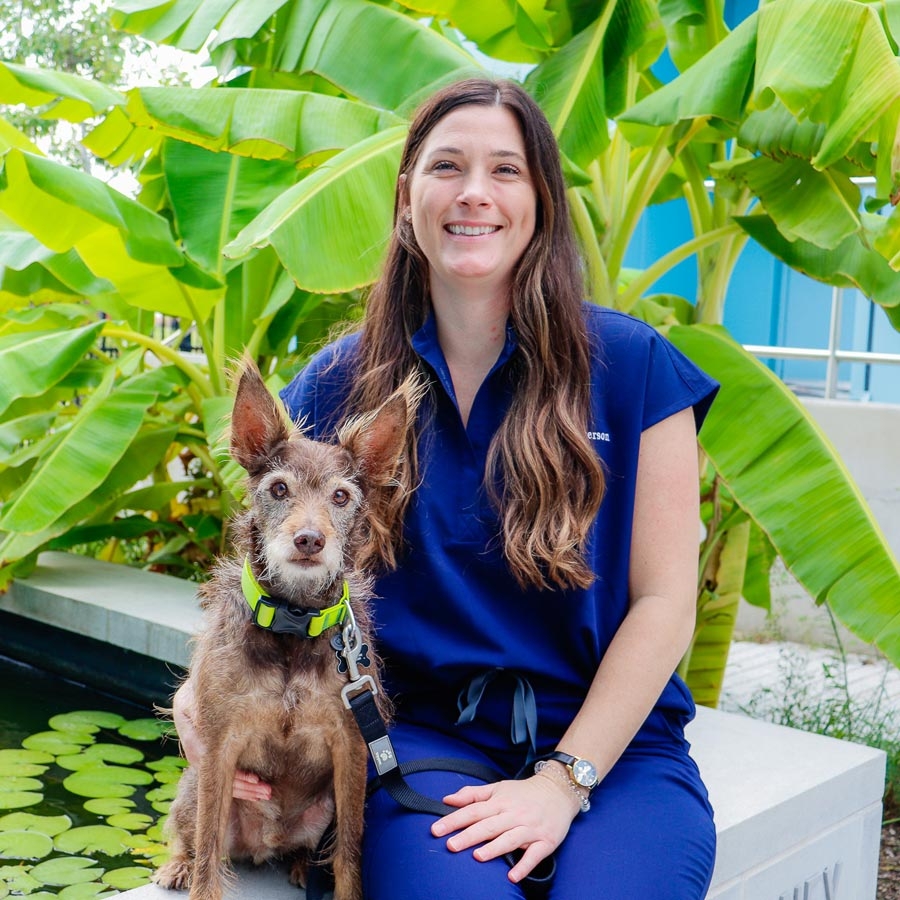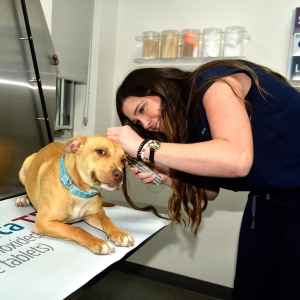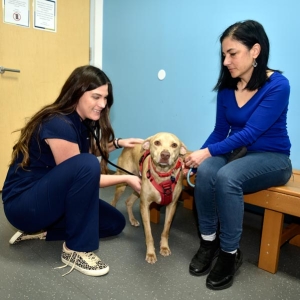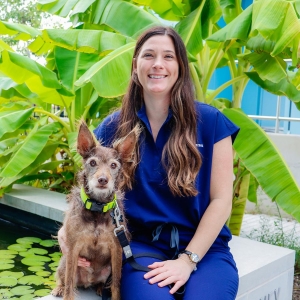Dogs in the summer just seem to go hand-in-paw with fond memories. Whether they’re galloping on a beach, lazing in the sun or leaving a trail of drool from the water dish to the shade of your hammock, dogs in the summer are our happy place. For dog owners, the only sound that epitomizes summer more than the shhh-tik-tik-tik-tik of a lawn sprinkler is the jangle of ID tags as their dogs shake their heads and scratch their ears. Why all the racket? Because summer often means ear infections for our canine companions.
In dogs, ear infections are often caused by environmental allergies. When the air gets warm, pollen, mold spores and other allergens begin to thrive and waft around on the currents, causing allergies to flare up. These allergies can make the skin that lines the ear canal inflamed, opening the door for secondary bacterial and fungal infections. If the musky odor emanating from your dog’s ear doesn’t tip you off to an infection, your dog may resort to rubbing their ear on the floor. Other signs may include red, inflamed skin lining your dog’s ear canal, waxy discharge, constant head shaking, ear-scratching and obvious pain. In fact, your dog may shy away from having their head touched at all. Left untreated, the skin may become cobbled or cauliflower-like in appearance and the ear canals can become swollen and permanently calcified. If the eardrum ruptures, the infection can enter the middle or inner ear and lead to hearing loss, loss of balance and neurological signs.
Dr Katie Severson, Chief Veterinarian at the Louisiana SPCA sees ear infections in the Community Clinic multiple times a day. It is a very common health concern, and the frequency increases during summer months.
Dr. Katie attended Louisiana State University in Baton Rouge for undergraduate studies and veterinary medical school. She graduated fourteen years ago as a member of the Phi Zeta Honor Society. Dr. Katie decided to become a veterinarian when she was nine years old. She was helping her vet treat her horse for a life-threatening concern. He had gotten into the trash can full of horse food and ate way too much. This can lead to multiple life-threatening concerns such as colic or laminitis. “We needed to perform a gastric lavage by passing a tube through his nose into his stomach and pump water in and out. It was the coolest thing I had ever seen, and my fate was sealed that day!” Admission to veterinary school is very hard to achieve. Dr. Katie was motivated while in school to make top scores by her love for animals and the desire to provide care for them when they couldn’t care for themselves. They depend on us, and she takes that responsibility very seriously. Dr. Katie has worked with many species and breeds throughout her career including horses, cows, dogs, cats, goats, and sheep. Her favorite species to work on is dogs and her favorite breed is the French Bulldog. She has two at home, Stella and Piggie Smalls. She adopted a ball python named Cheeto through the Louisiana SPCA last year. A new tenant found the snake behind the dryer when they moved in. He now lives in Dr. Katie’s living room sunning in a hammock. Dr. Katie also fosters dogs when given the chance. Right now, she’s fostering Starburst who is available for adoption through the Louisiana SPCA shelter! She is the sweetest; she loves to be snuggled but prefers women.
Community medicine is important to Dr. Katie because she sees “a rising need for affordable access to care in the veterinary industry now more than ever. As the cost-of-living increases and more veterinary clinics sell to corporate entities, it is important to me that animals are not left behind. Our number one goal is keeping pets and people together. In the Community Clinic, we do everything we can to keep the cost of basic veterinary care affordable while also providing additional assistance through donations and grants.”
She joined the Louisiana SPCA last year to help people and pets with more affordable care. “I have been harboring concerns for the affordability of veterinary care over the last few years as the cost of care continues to rise. Joining the Louisiana SPCA helped me feel good about the path I chose in life. My favorite part of treating pets at the Louisiana SPCA’s Wellness Clinic is being able to service a community in need. By providing affordable wellness care, owners have more money in their pocket to allocate to pet emergencies and/or supplies such as treats, toys, and food. We see pets and people from all over the area. We do not have income qualifiers to be seen in the Community Clinic.”
Launched in 1924, the Louisiana SPCA Community Clinic has grown far beyond anyone’s wildest imagination. What originally started off as a very small endeavor has now grown into an 8,000 square foot state-of-the-art veterinary clinic. With five exam rooms, two surgical suites, a dedicated heartworm treatment wing, on-site pharmacy and so much more, the Community Clinic is able to service thousands of pets in Louisiana each year. While their mission is rooted in spay/neuter, their services are always expanding and they’re proud to offer accessible and affordable services to pet parents regardless of where they live.
Clinical signs of an ear infection are shaking of the head, flapping of the ears, scratching the ears, pain or yelping when the ear is touched, leaning into your hand when the ear is rubbed, drainage from the ear canal, swelling and/or redness of the ear canal, or a foul odor coming from the ear. It's a good idea to have your pet checked by a veterinarian if he/she is showing any of these clinical signs. Ear infections can be very painful and if left untreated, can cause erosion and rupture of the ear drum.
Ears can get infected with bacteria, yeast, or parasites such as mites. Identifying the cause of an ear infection can be a complicated process. Sometimes the primary cause is ear confirmation such as large, pendulous or excessively hairy ears. This creates a warm moist environment, which is prime real estate for organisms such as yeast or bacteria. Another major factor is hypersensitivities to food or environmental allergens. Allergies cause inflammation of the skin including the skin of the ear canal. This inflammation leads to overgrowth and infection with organisms such as yeast or bacteria. Cats can also get infections due to yeast, bacteria, or mites just like dogs, but it is less common. While ear infections aren’t nearly as common in cats, outdoor cats can pick up ear mites in the summer, which can irritate the ears and lead to infection. Otoscopic examination is used to diagnosis symptoms such as redness, swelling, drainage, and an intact or ruptured ear drum. A microscopic examination is used to broadly identify the cause of infection such as bacteria, yeast or mites. The type of bacteria based on shape and stain type helps determine an appropriate treatment plan. Sometimes a culture and sensitivity are needed to identify the exact organism of infection and the medication it is sensitive to. This test is usually reserved for chronic or recurrent ear infections.
Certain breeds with pendulous ears are predisposed to ear infections such as Cocker Spaniels, hounds like Beagles and Bassets, Labrador Retrievers, Golden Retrievers, Poodles and poodle mixes, as well as pit bulls. Any breed with a predisposition to allergies will be predisposed to ear infections too. Health conditions such as hypothyroidism (low thyroid hormone) and tumors or masses in the ears may also lead to ear infections.
If your dog loves to swim, excess water in the ear canal can create the kind of dark, moist environment where yeast and bacteria thrive. It’s a good idea to clean their ears weekly with a medicated flush, as well as dry their ears when exiting water to prevent excessive moisture in the ear canal. Food allergies can cause ear infections, too, but in these cases, the infections tend to occur all year long rather than seasonally.
Dr. Katie does not recommend cleaning the ear canals with soap and water. When cleaning the ear canals, use a product labeled for ear cleaning, preferably one from your vet. Over the counter ear cleaners are good, but make sure you have checked with your vet on brand and ingredients. Home remedies for ear cleaning or treatment such as apple cider vinegar, peroxide, or rubbing alcohol should be avoided as they can cause more irritation to the ear and pain for your pet.
When cats and dog's ears are infected, they tend to shake their ears. Excessive shaking of the ears can cause more serious issues such as Aural Hematomas. This is caused by blood vessels in the ear breaking open and bleeding under the skin. You will not see bleeding, but the ear will be swollen and “squishy” to the touch. Treatment for Aural Hematomas can require surgery to prevent chronic disease and permanent disfiguration.
If left untreated, an ear infection will likely not heal on its own and can get worse leading to ear drum erosion and rupture. This allows the infection to travel into the middle and inner ear. Medial and inner ear infections can cause serious illness that affect the whole body. Untreated ear infections may cause permanent hearing loss.
Complicated, chronic, or recurrent ear infections can be frustrating for pets, owners, and veterinarians. There are many steps a veterinarian can take to properly diagnose and treat an ear infection. This process may include multiple rechecks, otoscopic examinations, cytology, cultures, food trials and medications. Your veterinarian will give your pet a full physical exam and most likely swab the ear canal for a sample. By viewing the ear debris under a microscope, they can determine if bacteria and/or yeast are involved. In some cases, they may recommend culturing the sample to identify the exact organisms and the best medications for treating them.
For some dogs, the ears may be so painful that a course of steroids may be required to help reduce swelling and inflammation before the ears can be handled. In severe cases, the dog may need to be anesthetized for a proper ear exam. Your veterinarian may perform other diagnostics, such as blood or allergy testing, to check for underlying health conditions.
The Louisiana SPCA carries routine ear cleaners for purchase locally and through the online pharmacy. They require an examination prior to purchasing products from their pharmacy. It is always best to let a veterinarian examine your dog’s ears to determine the best cleaner and cleaning regiment to use. Sometimes a point is reached where a specialist is the next step, and most specialists require a referral from a general practice veterinarian to schedule an appointment.
Dr. Katie would love to see your pet for an ear infection at the Louisiana SPCA located at 1700 Mardi Gras Blvd in New Orleans! You will need to make an appointment by calling (504) 368-5191 as their schedule can be tight; they are not seeing walk-ins currently.
In dogs, ear infections are often caused by environmental allergies. When the air gets warm, pollen, mold spores and other allergens begin to thrive and waft around on the currents, causing allergies to flare up. These allergies can make the skin that lines the ear canal inflamed, opening the door for secondary bacterial and fungal infections. If the musky odor emanating from your dog’s ear doesn’t tip you off to an infection, your dog may resort to rubbing their ear on the floor. Other signs may include red, inflamed skin lining your dog’s ear canal, waxy discharge, constant head shaking, ear-scratching and obvious pain. In fact, your dog may shy away from having their head touched at all. Left untreated, the skin may become cobbled or cauliflower-like in appearance and the ear canals can become swollen and permanently calcified. If the eardrum ruptures, the infection can enter the middle or inner ear and lead to hearing loss, loss of balance and neurological signs.
Dr Katie Severson, Chief Veterinarian at the Louisiana SPCA sees ear infections in the Community Clinic multiple times a day. It is a very common health concern, and the frequency increases during summer months.
Dr. Katie attended Louisiana State University in Baton Rouge for undergraduate studies and veterinary medical school. She graduated fourteen years ago as a member of the Phi Zeta Honor Society. Dr. Katie decided to become a veterinarian when she was nine years old. She was helping her vet treat her horse for a life-threatening concern. He had gotten into the trash can full of horse food and ate way too much. This can lead to multiple life-threatening concerns such as colic or laminitis. “We needed to perform a gastric lavage by passing a tube through his nose into his stomach and pump water in and out. It was the coolest thing I had ever seen, and my fate was sealed that day!” Admission to veterinary school is very hard to achieve. Dr. Katie was motivated while in school to make top scores by her love for animals and the desire to provide care for them when they couldn’t care for themselves. They depend on us, and she takes that responsibility very seriously. Dr. Katie has worked with many species and breeds throughout her career including horses, cows, dogs, cats, goats, and sheep. Her favorite species to work on is dogs and her favorite breed is the French Bulldog. She has two at home, Stella and Piggie Smalls. She adopted a ball python named Cheeto through the Louisiana SPCA last year. A new tenant found the snake behind the dryer when they moved in. He now lives in Dr. Katie’s living room sunning in a hammock. Dr. Katie also fosters dogs when given the chance. Right now, she’s fostering Starburst who is available for adoption through the Louisiana SPCA shelter! She is the sweetest; she loves to be snuggled but prefers women.
Community medicine is important to Dr. Katie because she sees “a rising need for affordable access to care in the veterinary industry now more than ever. As the cost-of-living increases and more veterinary clinics sell to corporate entities, it is important to me that animals are not left behind. Our number one goal is keeping pets and people together. In the Community Clinic, we do everything we can to keep the cost of basic veterinary care affordable while also providing additional assistance through donations and grants.”
She joined the Louisiana SPCA last year to help people and pets with more affordable care. “I have been harboring concerns for the affordability of veterinary care over the last few years as the cost of care continues to rise. Joining the Louisiana SPCA helped me feel good about the path I chose in life. My favorite part of treating pets at the Louisiana SPCA’s Wellness Clinic is being able to service a community in need. By providing affordable wellness care, owners have more money in their pocket to allocate to pet emergencies and/or supplies such as treats, toys, and food. We see pets and people from all over the area. We do not have income qualifiers to be seen in the Community Clinic.”
Launched in 1924, the Louisiana SPCA Community Clinic has grown far beyond anyone’s wildest imagination. What originally started off as a very small endeavor has now grown into an 8,000 square foot state-of-the-art veterinary clinic. With five exam rooms, two surgical suites, a dedicated heartworm treatment wing, on-site pharmacy and so much more, the Community Clinic is able to service thousands of pets in Louisiana each year. While their mission is rooted in spay/neuter, their services are always expanding and they’re proud to offer accessible and affordable services to pet parents regardless of where they live.
Clinical signs of an ear infection are shaking of the head, flapping of the ears, scratching the ears, pain or yelping when the ear is touched, leaning into your hand when the ear is rubbed, drainage from the ear canal, swelling and/or redness of the ear canal, or a foul odor coming from the ear. It's a good idea to have your pet checked by a veterinarian if he/she is showing any of these clinical signs. Ear infections can be very painful and if left untreated, can cause erosion and rupture of the ear drum.
Ears can get infected with bacteria, yeast, or parasites such as mites. Identifying the cause of an ear infection can be a complicated process. Sometimes the primary cause is ear confirmation such as large, pendulous or excessively hairy ears. This creates a warm moist environment, which is prime real estate for organisms such as yeast or bacteria. Another major factor is hypersensitivities to food or environmental allergens. Allergies cause inflammation of the skin including the skin of the ear canal. This inflammation leads to overgrowth and infection with organisms such as yeast or bacteria. Cats can also get infections due to yeast, bacteria, or mites just like dogs, but it is less common. While ear infections aren’t nearly as common in cats, outdoor cats can pick up ear mites in the summer, which can irritate the ears and lead to infection. Otoscopic examination is used to diagnosis symptoms such as redness, swelling, drainage, and an intact or ruptured ear drum. A microscopic examination is used to broadly identify the cause of infection such as bacteria, yeast or mites. The type of bacteria based on shape and stain type helps determine an appropriate treatment plan. Sometimes a culture and sensitivity are needed to identify the exact organism of infection and the medication it is sensitive to. This test is usually reserved for chronic or recurrent ear infections.
Certain breeds with pendulous ears are predisposed to ear infections such as Cocker Spaniels, hounds like Beagles and Bassets, Labrador Retrievers, Golden Retrievers, Poodles and poodle mixes, as well as pit bulls. Any breed with a predisposition to allergies will be predisposed to ear infections too. Health conditions such as hypothyroidism (low thyroid hormone) and tumors or masses in the ears may also lead to ear infections.
If your dog loves to swim, excess water in the ear canal can create the kind of dark, moist environment where yeast and bacteria thrive. It’s a good idea to clean their ears weekly with a medicated flush, as well as dry their ears when exiting water to prevent excessive moisture in the ear canal. Food allergies can cause ear infections, too, but in these cases, the infections tend to occur all year long rather than seasonally.
Dr. Katie does not recommend cleaning the ear canals with soap and water. When cleaning the ear canals, use a product labeled for ear cleaning, preferably one from your vet. Over the counter ear cleaners are good, but make sure you have checked with your vet on brand and ingredients. Home remedies for ear cleaning or treatment such as apple cider vinegar, peroxide, or rubbing alcohol should be avoided as they can cause more irritation to the ear and pain for your pet.
When cats and dog's ears are infected, they tend to shake their ears. Excessive shaking of the ears can cause more serious issues such as Aural Hematomas. This is caused by blood vessels in the ear breaking open and bleeding under the skin. You will not see bleeding, but the ear will be swollen and “squishy” to the touch. Treatment for Aural Hematomas can require surgery to prevent chronic disease and permanent disfiguration.
If left untreated, an ear infection will likely not heal on its own and can get worse leading to ear drum erosion and rupture. This allows the infection to travel into the middle and inner ear. Medial and inner ear infections can cause serious illness that affect the whole body. Untreated ear infections may cause permanent hearing loss.
Complicated, chronic, or recurrent ear infections can be frustrating for pets, owners, and veterinarians. There are many steps a veterinarian can take to properly diagnose and treat an ear infection. This process may include multiple rechecks, otoscopic examinations, cytology, cultures, food trials and medications. Your veterinarian will give your pet a full physical exam and most likely swab the ear canal for a sample. By viewing the ear debris under a microscope, they can determine if bacteria and/or yeast are involved. In some cases, they may recommend culturing the sample to identify the exact organisms and the best medications for treating them.
For some dogs, the ears may be so painful that a course of steroids may be required to help reduce swelling and inflammation before the ears can be handled. In severe cases, the dog may need to be anesthetized for a proper ear exam. Your veterinarian may perform other diagnostics, such as blood or allergy testing, to check for underlying health conditions.
The Louisiana SPCA carries routine ear cleaners for purchase locally and through the online pharmacy. They require an examination prior to purchasing products from their pharmacy. It is always best to let a veterinarian examine your dog’s ears to determine the best cleaner and cleaning regiment to use. Sometimes a point is reached where a specialist is the next step, and most specialists require a referral from a general practice veterinarian to schedule an appointment.
Dr. Katie would love to see your pet for an ear infection at the Louisiana SPCA located at 1700 Mardi Gras Blvd in New Orleans! You will need to make an appointment by calling (504) 368-5191 as their schedule can be tight; they are not seeing walk-ins currently.
Tagged in What's Up Doc in our Spring 2024 issue

